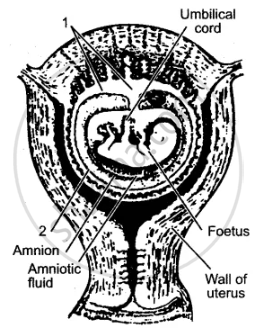Advertisements
Advertisements
प्रश्न
The diagram given below is that of a developing human foetus in the womb. Study the same and then answer the questions that follow:

- Name the parts '1' to '5' indicated by guidelines.
- What term is given to the period of development of the foetus in the womb?
- How many days does the foetus take to be fully developed?
- Mention two functions of the parts labelled ‘2’ other than its endocrine function.
- Name the hormone (anyone) produced by the part labelled ‘2’.
- What is the function of the part marked ‘3’?
उत्तर
-
- Umbilical cord
- Placenta
- Amniotic fluid
- Cervix
- Uterus wall
- Gestation period.
- 280 days.
- It provides nutrition and the exchange of respiratory gases by diffusion.
- Prevents foetuses from jerks and shocks. It also prevents the foetus from sticking to the uterine wall.
Notes
Student should refer their answer according to their question
APPEARS IN
संबंधित प्रश्न
Choose the odd one in each of the following :
Relaxin; cervix dilated; amniotic sac ruptures; child birth; follicle.
State whether the following statements are TRUE (T) or FALSE (F):
Rewrite the wrong statement by correcting only one word either at the beginning or at the end of the sentence.
Nutrition and oxygen diffuse from the mother’s blood into the foetus’s blood through amnion.
Given below are the names of certain stages/substances related to reproduction and found in human body. Answer the questions related to them.
Gestation
• What is its meaning?
• How long does it normally last?
Describe the functions of placenta
The diagram given alongside is that of a developing human foetus in the womb. Study the same and answer the questions that follows:
Name the parts ‘1’ to ‘5’ indicated by guidelines

What changes occur at the time of birth?
Study the diagram given below and then answer the questions that follow:

(i) Name the parts labeled 1 and 2. State the function of each part.
(ii) State any one function of the amniotic fluid.
(iii) What is the role of the umbilical cord in the development of the fetus?
(iv) Name the part in the diagram which is endocrine in nature.
In human beings, the placenta is formed by ______.
The haemoglobin of a human foetus ______.
Placenta produces certain hormones.
